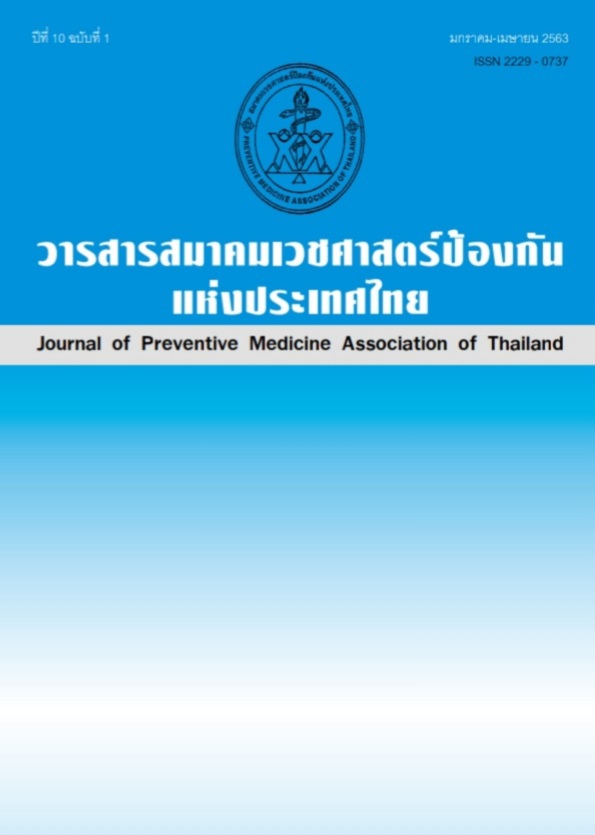Steven-Johnson syndrome and acute hepatitis induced by EBV infection : Case report
Keywords:
Steven-Johnson syndrome, Epstein-Barr virus (EBV)Abstract
Steven-Johnson syndrome (SJS) is a rare but severe dermatological condition and characterized by skin erythematous exanthema with possible evolution into vesiculobullous lesions and potentially induced by infectious agents (Mycoplasma pneumonia, Herpes simplex virus, Cytomegalovirus, EBV etc.) or drugs (anticonvulsants, antibiotics, NSAIDs etc.) and idiopathic causes. Infection is not a common cause of SJS although there have been case reports of Mycoplasma pneumonia but other infections such as herpes simplex virus, EBV is rare. EBV is in the same group as Herpes virus, causes infectious mononucleosis, usually found in adolescents and adults. This article reports a 43 years old woman who presented with fever for 4 days, erythema on the face, trunk and extremities. She was first diagnosed with fever with rash and was admitted for investigation and treatment. After a few days, she developed flaccid blisters on her trunk and forearms, painful erosions on tongue and buccal mucosa, hyperemia on both conjunctiva. Laboratory studies revealed high levels of serum aminotransferase, positive Anti-EBV (VCA) IgM serum and skin biopsy suggest to SJS. Finally, Steven-Johnson syndrome with acute hepatitis secondary to EBV infection was diagnosed. After 17 days of treatment, the patient had clinical improvement, the resolution of acute cutaneous manifestations and acute hepatitis had been for 1 month. The success of treatment depends on early recognition of the condition, prompt removal of the causative medications or infection and invasive supportive care in hospital. EBV may rarely associated with various patterns of skin eruptions but only a few cases of SJS and acute hepatitis induced by acute Epstien-Barr virus infection were diagnosed in the published literature.
References
2. Kunimi Y, Hirata Y, Aihara M, Yamane Y, Ikezawa Z. Statistical analysis of Stevens-Johnson syndrome caused by Mycoplasma pneumonia infection in Japan. Allergol Int 2011;60:525-32.
3. Tsai V, Oman J. Stevens-Johnson syndrome after mycoplasma pneumoniae infection. J Emerg Med 2011;40:324-27.
4. Tassaneeyakul W, Tiamkao S, Jantararoungtong T, Chen P, Lin SY, Chen WH, et al. Association between HLA-B*1502 and carbamazepine-induced severe cutaneous adverse drug reactions in a Thai population. Epilepsia 2010;51:926-30.
5. Duong TA, Valeyrie-Allanore L, Wolkenstein P, Chosidow O. Severe cutaneous adverse reactions to drugs. Lancet 2017;390:1996-2011.
6. Brunet-Possenti F, Steff M, Marinho E, Crickx B, Descamps V. Stevens-Johnson syndrome concurrent with primary Epstein-Barr virus infection. Ann Dermatol Venereol 2013;140:112-5.
7. Mockenhaupt M. The current understanding of Stevens-Johnson syndrome and toxic epidermal necrolysis. Expert Rev ClinImmunol 2011;7:803-13.
8. Lee HY, Martanto W, Thirunmoorthy T. Epidemiology of Stevens-Johnson syndrome and toxic epidermal necrolysis in Southeast Asia. Dermatol Sinica 2013;31:217-20.
9. Gerull R, Nelle M, Schaible T. Toxic epidermal necrolysis and Stevens-Johnson syndrome: a review. Crit Care Med 2011;39:1521-32.
10. Maggio MC, Liotta A, Cardella F, Corsello G. Stevens-Johnson syndrome and cholestatic hepatitis induced by acute Epstein-Barr virus infection. Eur J Gastroenterol Hepatol 2011;23:289.
Downloads
Published
How to Cite
Issue
Section
License
บทความที่ลงพิมพ์ในวารสารเวชศาสตร์ป้องกันแห่งประเทศไทย ถือเป็นผลงานวิชาการ งานวิจัย วิเคราะห์ วิจารณ์ เป็นความเห็นส่วนตัวของผู้นิพนธ์ กองบรรณาธิการไม่จำเป็นต้องเห็นด้วยเสมอไปและผู้นิพนธ์จะต้องรับผิดชอบต่อบทความของตนเอง






